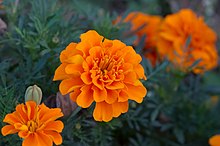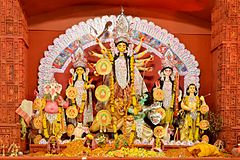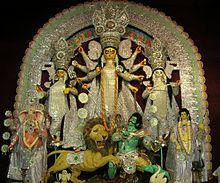Vijayadasami (Sanskrit: विजयदशमी) also known as Dussehra (Sanskrit: दशहरा) orAyudhapuja (Sanskrit: आयुधपूजा), is an important Hindu festival celebrated in a variety of ways in India and Nepal.
Vijayadasami (Sanskrit: विजयदशमी) also known as Dussehra (Sanskrit: दशहरा) orAyudhapuja (Sanskrit: आयुधपूजा), is an important Hindu festival celebrated in a variety of ways in India and Nepal.
Dasha Hara is a Sanskrit word which means removal of ten bad qualities within you*:
- Ahankara* (Ego)
- Amanavta* (Cruelty)
- Anyaaya* (Injustice)
- Kama vasana* (Lust)
- Krodha* (Anger)
- Lobha* (Greed)
- Mada* (Over Pride)
- Matsara* (Jealousy)
- Moha* (Attachment)
- Swartha* (Selfishness)
Hence, also known as *'Vijaydashami'* signifying *”Vijaya”* over these ten bad qualities.
Dasa-hara is a form of Dasanan ravan("Ravana's defeat").
The day marks the victory of Durga over the demon Mahishasura. The goddess fought with evil for ten days and nine nights.
- Vijayadasami" is derived from the Sanskritvijaya-dasami (victory on the dasami: the tenth day of the Hindu month). Diwali, the Festival of Lights, is celebrated twenty days after Vijayadasami.
Significance
Vijayadahami is celebrated on the tenth day of brighter fortnight the month of Ashwinaaccording to the Hindu calendar, corresponding to September or October of the Gregorian calendar. The first nine days are celebrated as Navratri (Devnagari: नवरात्रि, "nine nights"), culminating on the tenth day asDussehra.
Since the harvest season begins in India andNepal at this time, the Durga is invoked by religious rituals to begin the harvest season and renew the fertility of the soil. Many Hindus observe the festival with social gatherings and food offerings to the gods at home and in temples throughout India and Nepal.
Victory of Ram over Ravan

Ravana burning in effigy withsparklers in Manchester, 2006
On this day Ram (the seventh avatar ofVishnu) killed Ravana, who had abducted Rama's wife Sita to his kingdom Lanka. Rama, his brother Lakshmana, their discipleHanuman and an army fought a battle to rescue Sita. The story is recorded in the Hindu epic, the Ramayanam.
On the day of Ashvina Shukla Dasami, Rama defeated Ravana and rescued Sita. Based on inferences from Valmiki's Ramyanam,Kālidās's Raghuvaṃśa, Tulsidas’Ramcharitmanas and Keshavdas'Ramchandrika, Ram, Sita and Lakshman returned to Ayodhya on the 30th day of Ashwin (19–20 days after Vijayadasami). To celebrate Rama's return, in the evening the city's residents lit millions of earthen lamps (deepak); the day is celebrated in India as Deepawali (Diwali 2016).
Observers recite Sundara Kaand (the fifth book of the Ramayanam) for five days. Yajnas are thought to keep the household clean and healthy. Some perform yajnas andSandhyavandanam three times a day to keep the heart, brain and digestion balanced in the absence of adequate winter sunlight.
Durga's victory over Mahishasura
Main article: Mahishasura
Some of the demigods (asurs) were powerful and ambitious, and tried to defeat the devsand capture heaven. One asura, Mahishasura, grew powerful and wreaked havoc on earth. Under his leadership, the asuras defeated thedevas. The devas combined into Shakti (a mass of incandescent energy) to kill Mahishasura.
A bolt of lightning emerged from the mouths of Brahma, Vishnu and Siva, and a young, beautiful female virgin with ten hands appeared. The gods gave her their weapons, and Shakti coalesced to form the goddess Durga. On a lion who assisted her, Durga fought Mahishasura for nine days and nights; on the tenth day, Mahishasura was killed.Durga, as Siva's consort, represents two forms of female energy: mild and protective, and fierce and destructive.
Pandav exile
In the age of Dvapara Yuga, the pandavas(the five sons of Pandu [Sanskrit: पाण्डु] with his wife, Draupadi [Sanskrit: द्रौपदी] lost to theKauravas in a dice game and were exiled in the forest for twelve years. The brothers hid their weapons in a hole in a Shami tree before they entered the kingdom of Virat to complete their final year of exile. After that year, onVijayadasami they recovered the weapons, declared their true identities and defeated Kauravas, who had attacked King Virat to steal his cattle. Since that day, Shami treesand weapons have been worshiped and the exchange of Shami leaves on Vijayadasami has been a symbol of good will.
Kautsa's gift
Kautsa, the young son of a Brahmin named Devadatta, lived in Paithan. After completing his education with Rishi Varatantu, he insisted that his guru accept a present. The guru said, "Kautsa, to give dakshina in return for learning wisdom is not appropriate. Graduation of the disciple makes the guru happy, and that is the real Guru Dakshina.
Kautsa was not satisfied, since he still felt it his duty to give his guru something. The guru said, "All right, if you insist on giving medakshina, then give me 140 million gold coins—10 million for each of the 14 sciences I have taught you.
Kautsa went to King Raghu, an ancestor ofRama who was known for his generosity. However, at that time he had spent all his money on the Brahmins. Raghu asked Kautsa to return in three days, and left to get gold coins from Indra. Indra summoned Kuber, the god of wealth. Indra told Kuber, "Make gold coins rain on the Shanu and Aapati trees around Raghuraja's city of Ayodhya."
The rain of gold coins began. King Raghu gave the coins to Kautsa, who offered them to Varatantu Rishi. Since the guru had requested only 140 million, he returned the rest to Kautsa. Kautsa, considering honour more valuable than wealth, asked the king to take the remaining gold coins. The king refused, since kings do not take back a daan (gift).
Kautsa distributed the gold coins to the people of Ayodhya. To commemorate this, leaves are plucked form the Aapati tree and given as gifts.
Indian celebrations
Northern India
In Jammu and Kashmir, Himachal Pradesh,Gujarat, Rajasthan, Sindh, Uttar Pradesh,Haryana,Punjab, Uttarakhand and Bihar, it is tradition to plant barley in earthen pots on the first day of Navaratri. On the day of Dasara, the nine-day-old sprouts (called noratras ornortas) are used for luck; men place them in their caps or behind their ears.
In most of northern India and some parts of Maharashtra, Dasha-Hara is celebrated in honour of Rama. Plays based on theRamayana (Ramlila) are performed at outdoor fairs, and large parades with effigies of Ravana (a king of ancient Sri Lanka),Kumbhakarna and Meghanada are held. The effigies are burnt on bonfires in the evening. After Dasara, the hot summer ends (especially in North India) and the onset of cold weather is believed to encourage infections. The burning of the effigies, filled with firecrackers containing phosphorus, supposedly purifies the atmosphere.
In the Kumaon region of Uttarakhand, Dasara begins with the performance of a Ramlilabased on theatrical traditions begun by Uday Shankar during his stay in Almora and elaborated by Mohan Upreti and Brijendra Lal Sah. Known as the Almora or Kumaon style, the Ramlila was recognised by UNESCO in its 2008 report as a representative Indian style.
Himachal Pradesh
Main article: Kullu Dussehra
Kullu Dussehra, celebrated in the Kullu valley of Himachal Pradesh, begins on the tenth day of the rising moon and continues for seven days. Its history dates back to the 17th century, when King Jagat Singh installed an idol of Raghunath on his throne as a gesture of penance. After this, Raghunath was declared the ruling deity of the valley.
South India
Vijayadasami, celebrated in a variety of ways in South India, is seen as a day to express gratitude for success in life.[8] Celebrations range from worshipping Durga to displaying colorful figurines, known as a golu. To respect the deities' sacrifices, Hindus revere Murties(small statues of gods and goddesses) during festivals.
Vijayadasami is an auspicious day for beginning formal education. Students keep their books and workers their tools for puja on the ninth day of Navaratri (Ayudha Puja); these are taken back and used after puja on Vijayadasami. In many parts of South India, non-Hindus follow this tradition; in 2004, many churches in Kerala began school on this day.
South India
Vijayadasami is extremely important to theTelugu household. For life events, such as the beginning of a new business or the purchase of a new home or car, rituals are conducted to bless vehicles and other new items. In the evening, processions are held and Ramlilastaged. Effigies of Ravana, Kumbhakarna andIndrajittu are burned, signifying Rama's victory.
The festival is celebrated in Durga's temples, where shodasa upacharam is offered. During Navaratri, Durga is decorated in her different aspects: Bala Tripura Sundari, Mahishasura Mardhini, Annapoorna, Kali, Raja Rajeshwari, Kanaka Durga, Lakshmi, Saraswati and Gayatri Devi. On the riverbank at Vijayawada, in the temple of Sri Durga Malleswar Swami and on the Indra-Kila-Adri hill, Dasara and Navaratri are celebrated every year. The celebrations end on the tenth day, which is usually a national holiday. InVijayawada, Teppa Utsavam is celebrated on Vijayadasami; Durga's image is placed on a large boat decorated with flowers and lights in the evening.
Karnataka
Mysore Dasara is the Nadahabba (state-festival) of the state of Karnataka in India. It is also called Navaratri (Nava-ratri = nine-nights) and is a 10-day festival with the last day being Vijayadashami, the most auspicious day of Dasara. Dasara usually falls in the month of September or October. According to a legend, Vijayadashami denotes the victory of truth over evil and was the day when the Hindu GoddessChamundeshwari killed the demonMahishasura. Mahishasura is the demon whose slaying by the Goddess gave the nameMysore. The city of Mysore has a long tradition of celebrating the Dasara festival with utter grandeur and pomp to mark this day and the festivities there are an elaborate affair, attracting a large audience including foreigners. The Dasara festival completed 400th anniversary in year 2010.
Shivamogga Dasara, every year, a slew of cultural programmes, including a film festival, a theatre fest, a food mela, performances by music troupes, ‘Mahila Dasara’, ‘Yuva Dasara’, ‘Makkala Dasara’ and ‘Yoga Dasara’are organized in the 10-day cultural extravaganza, A colourful procession will be taken out in the main streets of the city on the day of Vijayadashami. Jamboo Savari, the main attraction of the Dasara festivities, was kick started by offering puja to the Nandidhwaj on the premises of Shivappa Nayaka Palace. The portrait of goddess Chamundeshwari was carried in a beautifully decorated wooden mantap mounted on the tusker. The Karadimajalu, Keelukunita, Dollukunita, Veeragase, Tattiraya troupes of folk artistes perform along the procession. The police band, Scouts and Guides and National Cadet Corps also participate in the procession.
The procession passes through Ramanna Shreshti Park, Amir Ahmed Circle, Gopi Circle, Jail Circle, Kuvempu Road, Shivappa Nayaka Circle and Mahaveer Circle before culminating at the NES grounds. Shimoga tahshildar performs the Banni puja, Ravan dahan, a ritual of burning a huge effigy of Ravan were held after the Banni Pooja. A spectacular display of fireworks has been organised after the Ravan dahan.
Andhra Pradesh and Telangana
In Andhra Pradesh and Telangana, family members seek blessing from their elders by giving them leaves from the shami tree. Vijayadasami is a indication of win. Ayudhapooja and dhurga Pooja is a most commonly happening thing. On the day of dassara younger get blessings from elders by distributing Jambi.
Tamil Nadu and Kerala
The ninth day of Navratri is celebrated asSaraswati Puja. The day begins with the Puja Veypu (worship) at home, in a traditional nursery school or at the local temple. On Vijayadashami, Vidyarambham is celebrated when children begin their education. The child writes for the first time with their index finger on rice spread in a plate, guided by a family elder or by a teacher. Ayudha Puja, the blessing of tools used for work (ayudhameans "tools") is also celebrated by businesses and factories at this time.
Western India
Maharashtra

Marigold (tagetes patula) flowers, known in Marathi as jhendu (झेंडू), are popular at this time.
In Maharashtra, the deities installed on the first day of Navratri are immersed in water. Observers visit each other and exchange sweets.
The bidi leaf (apta) tree is worshiped, and its leaves (signifying gold) are exchanged as wishes for a bright, prosperous future. The tradition of apta leaves is symbolic of Raghuraja, an ancestor of Rama and Kubera. Communities of artisans worship their tools, resting them on this day. Saffron-coloured marigolds, popular during the festival, are used for worship and decoration.
On Vijayadashami, observers ritually cross the border of their community in a ceremony known as Simollanghan (Marathi: सीमोल्लंघन, "crossing the border"). This practice has its roots in the belief that the day is an auspicious one to begin a new venture.
Eastern India
Bihar
People do fast during pooja from 1st day to 10th days. They eat only fruits and sweets. All particular places pandal will be there and all pandals. there will be statue of Lord Kartik, Ganesh, Goddess Lakhsmi, Saraswati along with goddess durga and demon mahishasura,. We can hear the sounds of mantra during all the ten days. People don't eat non veg during durga pooja. There will competition everywhere in for decoration and Pandal. All pandals will be based on some particular's themes. Durga pooja is the on of the main fevstival of Bihar after Deepawali and Chath Pooja.
Bengal

Vermilion applied to Durga's forehead during Vijayadashami
Ashok Vijaya Dashmi
See also: Dalit Buddhist movement
Followers of B. R. Ambedkar (Ambedkarite Buddhists) celebrate the festival as Ashok Vijayadashmi, since the Mauryan EmperorAshoka is believed to have converted to Buddhism on this day. Ambedkar converted to Buddhism on this day atDeekshabhoomi, Nagpur in 1956, which fell on 14 October that year. A festival and congregation is held at Nagpur, Maharashtra. Ambedkarite Buddhists organize community celebrations with speeches, meals and Buddhist-themed entertainment.
Celebrations In Other Parts of South Asia / Indian subcontinent
Vijayadashami also celebrates Vyasa, the author of (and a character in) theMahabharata.
Nepal

Family elder applying a tilaka to a younger member
Vijayadashami (विजयादशमी) (also known asDashain (दशैं) is celebrated by Hindu and non-Hindu Nepalis. The Newar people celebrate it as Mohani. The 10th day of Dashain is Vijayadashami, on which elders place a tilakaon the forehead of younger family members.Jamara is sown on the festival's first day; it becomes greenish-yellow and grows to 10–20 centimetres (3.9–7.9 in) long, symbolizing victory. Some ethnic groups receive tilaka and jamara only on the 10th day, and others receive it until the following full moon. Depending upon the relationship, observers offer a dakshina for the tilaka and jamara. On the eighth day of the festival, observers sacrifice animals to Durga and their meat is eaten as a gift from the goddess. The 15-day festival is a time for visiting relatives and temples dedicated to Durga and purchasing new clothes.
Bangladesh
In Bangladesh, the festival is five days long festival and is celebrated in mandapas(congregations). The largest festival is held at the Dhakeshwari temple and Ramkrishna mission in Dhaka. On Vijayadashami, clay statues of Durga are immersed in rivers. Thepuja is performed with turmeric and other items, which are added to the river to help the water produce better crops.





No comments:
Post a Comment